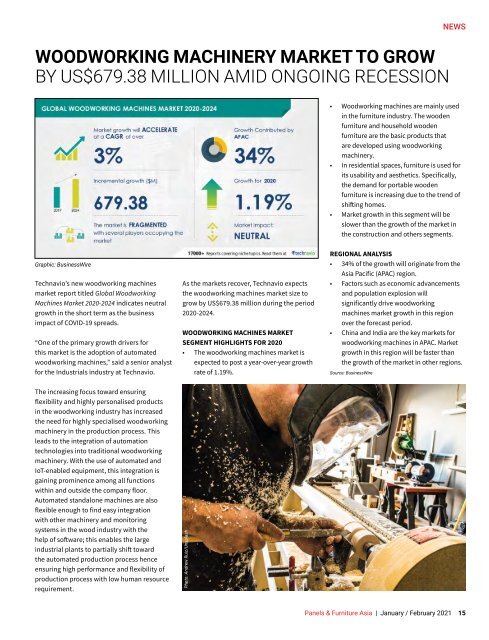Panels & Furniture Asia January/February 2021
Panels & Furniture Asia (PFA) is a leading regional trade magazine dedicated to the woodbased panel, furniture and flooring processing industry. Published bi-monthly since 2000, PFA delivers authentic journalism to cover the latest news, technology, machinery, projects, products and trade events throughout the sector. With a hardcopy and digital readership comprising manufacturers, designers and specifiers, among others, PFA is the platform of choice for connecting brands across the global woodworking landscape.
Panels & Furniture Asia (PFA) is a leading regional trade magazine dedicated to the woodbased panel, furniture and flooring processing industry. Published bi-monthly since 2000, PFA delivers authentic journalism to cover the latest news, technology, machinery, projects, products and trade events throughout the sector. With a hardcopy and digital readership comprising manufacturers, designers and specifiers, among others, PFA is the platform of choice for connecting brands across the global woodworking landscape.
You also want an ePaper? Increase the reach of your titles
YUMPU automatically turns print PDFs into web optimized ePapers that Google loves.
WOODWORKING MACHINERY MARKET TO GROW<br />
BY US$679.38 MILLION AMID ONGOING RECESSION<br />
NEWS<br />
• Woodworking machines are mainly used<br />
in the furniture industry. The wooden<br />
furniture and household wooden<br />
furniture are the basic products that<br />
are developed using woodworking<br />
machinery.<br />
• In residential spaces, furniture is used for<br />
its usability and aesthetics. Specifically,<br />
the demand for portable wooden<br />
furniture is increasing due to the trend of<br />
shifting homes.<br />
• Market growth in this segment will be<br />
slower than the growth of the market in<br />
the construction and others segments.<br />
Graphic: BusinessWire<br />
Technavio’s new woodworking machines<br />
market report titled Global Woodworking<br />
Machines Market 2020-2024 indicates neutral<br />
growth in the short term as the business<br />
impact of COVID-19 spreads.<br />
“One of the primary growth drivers for<br />
this market is the adoption of automated<br />
woodworking machines,” said a senior analyst<br />
for the Industrials industry at Technavio.<br />
As the markets recover, Technavio expects<br />
the woodworking machines market size to<br />
grow by US$679.38 million during the period<br />
2020-2024.<br />
WOODWORKING MACHINES MARKET<br />
SEGMENT HIGHLIGHTS FOR 2020<br />
• The woodworking machines market is<br />
expected to post a year-over-year growth<br />
rate of 1.19%.<br />
REGIONAL ANALYSIS<br />
• 34% of the growth will originate from the<br />
<strong>Asia</strong> Pacific (APAC) region.<br />
• Factors such as economic advancements<br />
and population explosion will<br />
significantly drive woodworking<br />
machines market growth in this region<br />
over the forecast period.<br />
• China and India are the key markets for<br />
woodworking machines in APAC. Market<br />
growth in this region will be faster than<br />
the growth of the market in other regions.<br />
Source: BusinessWire<br />
The increasing focus toward ensuring<br />
flexibility and highly personalised products<br />
in the woodworking industry has increased<br />
the need for highly specialised woodworking<br />
machinery in the production process. This<br />
leads to the integration of automation<br />
technologies into traditional woodworking<br />
machinery. With the use of automated and<br />
IoT-enabled equipment, this integration is<br />
gaining prominence among all functions<br />
within and outside the company floor.<br />
Automated standalone machines are also<br />
flexible enough to find easy integration<br />
with other machinery and monitoring<br />
systems in the wood industry with the<br />
help of software; this enables the large<br />
industrial plants to partially shift toward<br />
the automated production process hence<br />
ensuring high performance and flexibility of<br />
production process with low human resource<br />
requirement.<br />
Photo: Andrew Ruiz/Unsplash<br />
<strong>Panels</strong> & <strong>Furniture</strong> <strong>Asia</strong> | <strong>January</strong> / <strong>February</strong> <strong>2021</strong> 15


















